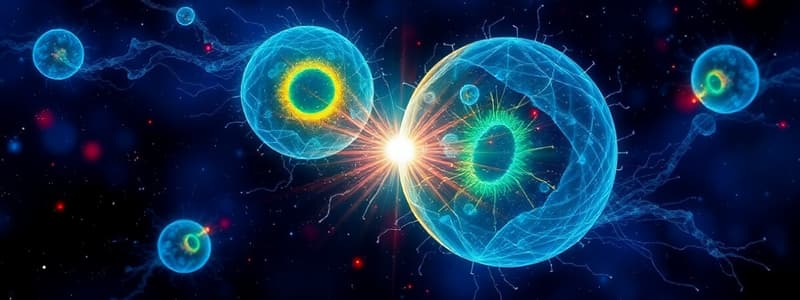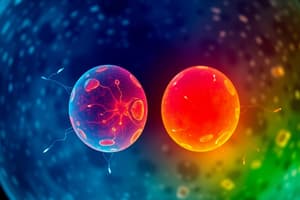Podcast
Questions and Answers
What is the main difference between mitosis and meiosis in terms of the number of cell divisions?
What is the main difference between mitosis and meiosis in terms of the number of cell divisions?
- Both mitosis and meiosis divide once.
- Mitosis divides once while meiosis divides twice. (correct)
- Mitosis divides twice while meiosis divides once.
- Both mitosis and meiosis divide twice.
What type of cells are produced at the end of meiosis?
What type of cells are produced at the end of meiosis?
- Haploid gametes. (correct)
- Diploid cells.
- Somatic cells.
- Stem cells.
Which term describes cells with two sets of chromosomes?
Which term describes cells with two sets of chromosomes?
- Tetraploid.
- Diploid. (correct)
- Monoploid.
- Haploid.
In which type of nuclear division is the purpose mainly to produce gametes?
In which type of nuclear division is the purpose mainly to produce gametes?
Which describes the final outcome of mitosis compared to meiosis?
Which describes the final outcome of mitosis compared to meiosis?
What is the main difference between Meiosis II and mitosis?
What is the main difference between Meiosis II and mitosis?
Which stage of Meiosis II involves the sister chromatids being pulled apart?
Which stage of Meiosis II involves the sister chromatids being pulled apart?
What type of daughter cells are produced at the end of Meiosis II?
What type of daughter cells are produced at the end of Meiosis II?
During which phase of Meiosis II does the nuclear envelope disintegrate?
During which phase of Meiosis II does the nuclear envelope disintegrate?
What is the primary purpose of meiosis in terms of chromosome number?
What is the primary purpose of meiosis in terms of chromosome number?
How many nuclear divisions occur during meiosis?
How many nuclear divisions occur during meiosis?
What is the result of meiosis in terms of genetic variation?
What is the result of meiosis in terms of genetic variation?
Which process increases genetic variation during meiosis?
Which process increases genetic variation during meiosis?
How does mitosis differ from meiosis in terms of the number of daughter cells produced?
How does mitosis differ from meiosis in terms of the number of daughter cells produced?
In which locations does meiosis primarily occur?
In which locations does meiosis primarily occur?
What describes the genetic content of daughter cells produced by mitosis?
What describes the genetic content of daughter cells produced by mitosis?
Which of the following statements about haploid cells is true?
Which of the following statements about haploid cells is true?
Flashcards
Haploid cell
Haploid cell
A cell containing half the number of chromosomes of a diploid cell.
Crossing over
Crossing over
Exchange of genetic material between non-sister chromatids of homologous chromosomes in Prophase I of Meiosis.
Random assortment
Random assortment
Random alignment of homologous chromosomes at the metaphase plate during Meiosis I.
Meiosis
Meiosis
Signup and view all the flashcards
Genetic variation
Genetic variation
Signup and view all the flashcards
Diploid cell
Diploid cell
Signup and view all the flashcards
Meiosis I
Meiosis I
Signup and view all the flashcards
Meiosis II
Meiosis II
Signup and view all the flashcards
Meiosis II Stages
Meiosis II Stages
Signup and view all the flashcards
Prophase II (Meiosis II)
Prophase II (Meiosis II)
Signup and view all the flashcards
Haploid daughter cells
Haploid daughter cells
Signup and view all the flashcards
Purpose of Meiosis
Purpose of Meiosis
Signup and view all the flashcards
Gametes
Gametes
Signup and view all the flashcards
Diploid
Diploid
Signup and view all the flashcards
Haploid
Haploid
Signup and view all the flashcards
What is the purpose of Meiosis?
What is the purpose of Meiosis?
Signup and view all the flashcards
Study Notes
Mitosis and Meiosis
- Meiosis is a type of nuclear division where a single cell divides twice to produce four cells, each containing half the amount of DNA as the original cell.
- These resulting four cells are the sex cells (gametes), such as sperm in males and eggs in females.
- Mitosis is a type of nuclear division where a single cell divides once to produce two daughter cells containing the same amount of DNA as the original cell.
Diploid and Haploid
- Cells have 2n DNA (one set from each parent). These are called diploid cells.
- In mitosis, the goal is to make more of the same type of cells, resulting in two 2n daughter cells from one 2n parent cell.
- In meiosis, the goal is to produce sex gametes. This leads to four n (haploid) daughter cells from one 2n parent cell, each with half the original DNA.
- A sperm cell (n, haploid) fertilizes an egg cell (n, haploid) to produce a diploid (2n) fertilized egg (zygote).
Meiosis Involves Two Rounds of Nuclear Division
- Meiosis I (first meiotic division)
- Meiosis II (second meiotic division)
- Meiosis II is similar to mitosis.
Meiosis I Stages
- Prophase I: Chromosomes condense, nuclear envelope breaks down, spindle fibers form, and homologous chromosomes pair up (crossing over occurs).
- Metaphase I: Homologous chromosomes align at the equator of the cell in a random arrangement (random assortment).
- Anaphase I: Homologous chromosomes separate and move to opposite poles of the cell.
- Telophase I: Chromosomes decondense, spindle fibers disappear, and nuclear membranes form. Cytokinesis follows, creating two haploid daughter cells.
Crossing Over
- During prophase I, homologous chromosomes are tangled together. This is called "crossing over."
- Exchange of genes between homologous chromosomes, mixing paternal and maternal characteristics.
- This is a key strategy for generating genetic variation.
Meiosis II Stages
- Prophase II: Chromatin condenses, nuclear envelope breaks down, spindle fibers form, and centrioles move to opposite poles.
- Metaphase II: Sister chromatids align at the equator of the cell.
- Anaphase II: Sister chromatids separate and move to opposite poles.
- Telophase II: Chromosomes decondense, spindle fibers disappear, and nuclear membranes reform. Cytokinesis follows, creating four haploid daughter cells.
Random Assortment
- During metaphase I, homologous chromosomes align randomly at the equator of the cell.
- This means there is no guarantee of which chromosome from each parent will be pulled to which pole. This is another key strategy for generating genetic variation.
Spermatogenesis (sperm production)
- Starts with diploid spermatogonium, which divides by meiosis to produce four haploid spermatids that mature into sperm cells.
Oogenesis (egg production)
- Begins with diploid oogonium, which divides by meiosis to produce one mature ovum (egg) and three polar bodies. The polar bodies degenerate.
Why Meiosis is Important
- Meiosis produces sperm cells and egg cells with half the number of chromosomes (haploid) compared to body cells.
- Meiosis involves crossing over and random assortment, generating genetic variation in the gametes, and thus in zygotes and offspring.
Mitosis vs Meiosis: Key Differences
| Feature | Mitosis | Meiosis |
|---|---|---|
| Products | Two genetically identical daughter cells | Four genetically different daughter cells |
| Daughter cells | Diploid (same number of chromosomes) | Haploid (half the number of chromosomes) |
| Where? | Normal body cells (growth/repair) | Reproductive organs (sperm/egg formation) |
| Nuclear division | One round of division | Two rounds of division |
| Genetic variation | No genetic variation | Yes (crossing over and random assortment) |
Studying That Suits You
Use AI to generate personalized quizzes and flashcards to suit your learning preferences.



